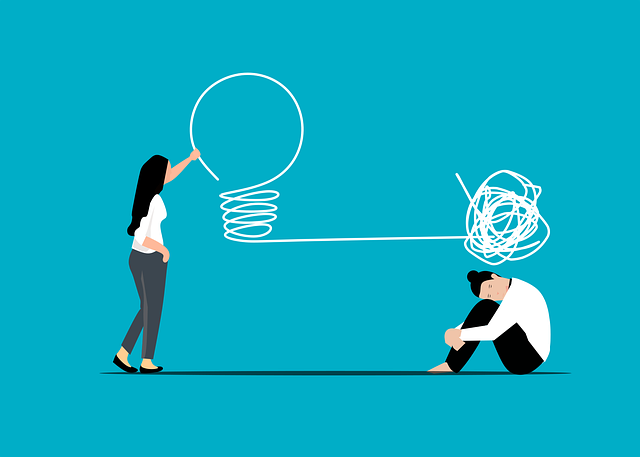Modern life's pressures often lead to chronic stress, impacting mental and physical health. Stress relief therapy offers various therapeutic approaches like CBT, mindfulness, and relaxation exercises to manage triggers and reduce stress. Personalized sessions with trained professionals enhance well-being, address emotional issues, and improve physical health markers. Methods include CBT for negative thought patterns, MBSR for present-moment awareness, EMDR for trauma, and Yoga/Tai Chi for relaxation through movement. Preparing for therapy by reflecting on stressors and researching approaches ensures a productive first session. Integrating stress relief techniques into daily routines fosters proactive management, making therapy a lifelong practice. Choosing the right therapist with suitable qualifications and experience is crucial for effective treatment and improved mental health.
Stress relief therapy is a powerful tool to reclaim your well-being. In today’s fast-paced world, understanding and managing stress effectively is crucial for overall health. This comprehensive guide explores various aspects of therapy as a solution. From recognizing stress triggers to discovering tailored techniques, we’ll navigate the benefits, types, and practices. Learn how preparation and integration contribute to long-term stress management, ensuring you find the perfect therapist aligned with your unique needs.
Understanding Stress and Its Impact

Stress is a natural response to demanding situations, but chronic or prolonged stress can have detrimental effects on both mental and physical health. It’s crucial to recognize that our modern lifestyles often contribute to heightened stress levels due to work pressures, personal relationships, financial worries, or even constant connectivity through technology. This persistent stress can lead to a range of issues, from anxiety and depression to cardiovascular problems and weakened immune systems.
Fortunately, various therapeutic approaches have been developed to offer effective stress relief therapy. These include techniques such as cognitive-behavioural therapy (CBT), mindfulness practices, and relaxation exercises. By understanding the underlying causes and triggers of stress, individuals can gain valuable tools to manage and reduce its impact on their daily lives.
The Benefits of Therapy for Stress Relief

Stress relief therapy offers a multitude of benefits that extend far beyond mere relaxation. Through structured sessions with a trained professional, individuals can gain valuable insights into their stress triggers and develop effective coping mechanisms tailored to their unique needs. This not only enhances overall mental well-being but also positively impacts physical health by lowering blood pressure, improving sleep patterns, and boosting the immune system.
Moreover, therapy provides a safe and supportive environment where one can explore underlying emotional issues contributing to stress. By addressing these root causes, individuals can foster resilience, improve their ability to manage challenging situations, and cultivate a deeper sense of self-awareness and inner calm. Stress relief therapy, thus, empowers individuals to lead more fulfilling lives, balancing the demands of daily responsibilities with enhanced mental and physical health.
Different Types of Therapies for Managing Stress

Stress relief therapy takes many forms, each tailored to address unique aspects of an individual’s stress experience. Cognitive Behavioral Therapy (CBT) is a popular approach that focuses on identifying and changing negative thought patterns and behaviors contributing to stress. By reframing one’s perspective, CBT empowers individuals to manage stressors more effectively. Another effective method is Mindfulness-Based Stress Reduction (MBSR), which teaches present-moment awareness through meditation and breathing exercises, helping people detach from stressful thoughts and emotions.
Additionally, various other therapies offer stress relief, such as Eye Movement Desensitization and Reprocessing (EMDR), which facilitates the processing of traumatic memories, and Yoga and Tai Chi, integrating physical movement with breath control to promote relaxation. Each therapy offers distinct benefits, catering to diverse needs for achieving stress relief therapy and fostering mental well-being.
Preparing for Your First Therapy Session

Preparing for your first therapy session is a crucial step in your journey towards stress relief. It’s normal to feel anxious or unsure about what to expect. One helpful practice is to set aside time to reflect on your current stressors and any specific goals you hope to achieve from therapy. Consider writing them down, as this can provide clarity during your initial conversation with the therapist.
Before your session, gather information about different types of stress relief therapy that might be suitable for you. Research common therapeutic approaches, such as cognitive behavioural therapy (CBT) or mindfulness-based practices, to better understand their benefits and potential fit for your needs. Arriving prepared will enable a more productive first meeting, fostering a strong foundation for your therapy journey towards managing and reducing stress.
Techniques Used in Stress Relief Therapy

Stress relief therapy employs a variety of evidence-based techniques tailored to each individual’s unique needs and preferences. Common approaches include mindfulness meditation, which teaches individuals to focus on the present moment, thereby reducing anxious thoughts about the future or regrets about the past. Cognitive behavioral therapy (CBT) is another effective method that helps people identify and change negative thought patterns contributing to stress. This can involve challenging unhelpful beliefs and replacing them with more realistic, positive ones.
In addition, breathing exercises and progressive muscle relaxation are integral parts of many stress relief therapy programs. These techniques promote deep, conscious breathing and progressively tense and then relax different muscle groups, facilitating a sense of calm and reducing physical tension associated with stress. Furthermore, therapies like yoga and tai chi combine mindful movement with breathwork, offering both physical and mental benefits for stress management.
Integrating Therapy into Daily Life for Long-Term Stress Management

Integrating therapy into daily life is a powerful strategy for long-term stress management. Stress relief therapy provides individuals with valuable tools and techniques to navigate challenging situations, fostering resilience and emotional well-being. By consistently practicing what’s learned in therapy sessions, one can cultivate healthier coping mechanisms that seamlessly fit into their routine. This integration allows for proactive stress prevention, ensuring that the benefits of therapy extend beyond the treatment room.
For lasting results, it’s essential to view therapy as a lifelong practice rather than a temporary fix. Regularly scheduled check-ins with a therapist or even incorporating self-care practices like mindfulness and meditation can make this integration more manageable. Over time, these practices become second nature, enhancing overall mental fortitude and equipping individuals to face life’s stressors head-on.
Finding the Right Therapist for Your Needs

Finding the right therapist is a crucial step in your journey towards effective stress relief. It’s essential to consider your unique needs and preferences when choosing someone to support your mental well-being. Start by researching different therapeutic modalities, as various approaches exist, each tailored to specific concerns. For instance, cognitive behavioural therapy (CBT) focuses on identifying and changing negative thought patterns, making it ideal for managing stress and anxiety. Other options include mindfulness-based therapies, which teach present-moment awareness to reduce stress responses.
During your search, consider factors like the therapist’s qualifications, experience, and areas of specialisation. Personal connection matters too; you want to feel comfortable and understood. Don’t hesitate to reach out for consultations or initial sessions to gauge compatibility. The right therapist will create a safe space, offering tools and strategies to manage stress effectively and enhance your overall well-being.
